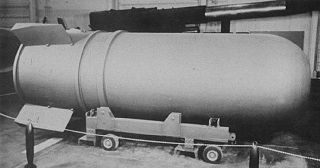Related Research Articles

The B83 is a variable-yield thermonuclear gravity bomb developed by the United States in the late 1970s that entered service in 1983. With a maximum yield of 1.2 megatonnes of TNT (5.0 PJ), it has been the most powerful nuclear weapon in the United States nuclear arsenal since October 25, 2011 after retirement of the B53. It was designed by Lawrence Livermore National Laboratory.

The B28, originally Mark 28, was a thermonuclear bomb carried by U.S. tactical fighter bombers, attack aircraft and bomber aircraft. From 1962 to 1972 under the NATO nuclear weapons sharing program, American B28s also equipped six Europe-based Canadian CF-104 squadrons known as the RCAF Nuclear Strike Force. It was also supplied for delivery by UK-based Royal Air Force Valiant and Canberra aircraft assigned to NATO under the command of SACEUR. In addition, certain U.S. Navy carrier based attack aircraft such as the A3D Skywarrior, A4D Skyhawk, and A3J Vigilante were equipped to carry the B28.

The B-41 was a thermonuclear weapon deployed by the United States Strategic Air Command in the early 1960s. It was the most powerful nuclear bomb ever developed by the United States, with a maximum yield of 25 megatons of TNT. The B-41 was the only three-stage thermonuclear weapon fielded by the U.S.

The W80 is a low to intermediate yield two-stage thermonuclear warhead deployed by the U.S. enduring stockpile with a variable yield ("dial-a-yield") of 5 or 150 kilotonnes of TNT.

The W88 is an American thermonuclear warhead, with an estimated yield of 475 kilotonnes of TNT (1,990 TJ), and is small enough to fit on MIRVed missiles. The W88 was designed at the Los Alamos National Laboratory in the 1970s. In 1999, the director of Los Alamos who had presided over its design described it as "the most advanced U.S. nuclear warhead". As of 2021, the latest version is called the W88 ALT 370, the first unit of which came into production on 1 July, 2021, after 11 years of development. The Trident II submarine-launched ballistic missile (SLBM) can be armed with up to eight W88 warheads or twelve 100 kt W76 warheads, but it is limited to eight warheads under the Strategic Offensive Reductions Treaty.

The W85 was a thermonuclear warhead developed by the United States of America to arm the Pershing II missile. It was a variable yield device with a selectable yield of 0.3, 5, 10 or 80 kilotonnes of TNT.

The explosive yield of a nuclear weapon is the amount of energy released when that particular nuclear weapon is detonated, usually expressed as a TNT equivalent (the standardized equivalent mass of trinitrotoluene which, if detonated, would produce the same energy discharge), either in kilotonnes (kt—thousands of tonnes of TNT), in megatonnes (Mt—millions of tonnes of TNT), or sometimes in terajoules (TJ). An explosive yield of one terajoule is equal to 0.239 kilotonnes of TNT. Because the accuracy of any measurement of the energy released by TNT has always been problematic, the conventional definition is that one kilotonne of TNT is held simply to be equivalent to 1012 calories.
W70 was a two-stage, thermonuclear warhead that was developed for the MGM-52 Lance missile by the United States. Designed by Lawrence Livermore National Laboratory, the Mod 1 and Mod 2 version of the weapon entered service in 1973, while the enhanced radiation Mod 3 weapon entered service in 1981. The last W70 warhead was dismantled in February 1996.

Medium Atomic Demolition Munition (MADM) was a tactical nuclear weapon developed by the United States during the Cold War. It was an Atomic demolition munition, a combat engineering device for demolition of structures and for battlefield shaping. The device contained a W45 warhead with an estimated yield of 0.5 to 15 kilotonnes of TNT. Each MADM weighed 391 pounds (177 kg) in its transportation container. They were deployed between 1962 and 1986.
The W66 thermonuclear warhead was used on the Sprint anti-ballistic missile system, designed to be a short-range interceptor to shoot down incoming ICBM warheads.

The W78 is an American thermonuclear warhead with an estimated yield of 335–350 kilotonnes of TNT (1,400–1,460 TJ), deployed on the LGM-30G Minuteman III intercontinental ballistic missile (ICBM) and housed in the Mark 12A reentry vehicle. Minuteman III initially carried the older W62 warhead with a yield of 170 kilotonnes of TNT (710 TJ), but starting in December 1979 and ending in February 1982, some W62 were replaced with the W78. It is publicly estimated that 1083 warheads were manufactured.

The W84 is an American thermonuclear warhead initially designed for use on the BGM-109G Gryphon Ground Launched Cruise Missile (GLCM).

The W56 was an American thermonuclear warhead produced starting in 1963 which saw service until 1993, on the Minuteman I and II ICBMs.

The W59 was an American thermonuclear warhead used on some Minuteman I ICBM missiles from 1962 to 1969, and planned to be used on the cancelled GAM-87 Skybolt air-launched ballistic missile.

The W91 was an American thermonuclear warhead intended for use on the SRAM-T variant of the AGM-131 SRAM II air to ground missile.

The Mark 8 nuclear bomb was an American nuclear bomb, designed in the late 1940s and early 1950s, which was in service from 1952 to 1957.

The W31 was an American nuclear warhead used for two US missiles and as an atomic demolition munition.
Kinglet was a boosted fission primary used in several American thermonuclear weapons.

The W33 was an American nuclear artillery shell designed for use in the 8-inch (203 mm) M110 howitzer and M115 howitzer.
References
- ↑ DCI Briefing to Joint Chiefs of Staff (PDF) (Report). 1963-07-30. p. 20. Archived (PDF) from the original on 2021-11-06. Retrieved 2021-11-06.
- 1 2 Sublette, Carey (2019-11-11). "List of All U.S. Nuclear Weapons". nuclearweaponarchive.org. Retrieved 2019-11-12.
- 1 2 Gibson, James Norris. (1989). The history of the US nuclear arsenal. Greenwich, CT: Brompton Books Corp. p. 90. ISBN 0861245644. OCLC 21588268.